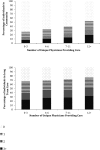Anticholinergic Drug Burden in Persons with Dementia Taking a Cholinesterase Inhibitor: The Effect of Multiple Physicians
- PMID: 27000323
- PMCID: PMC4819524
- DOI: 10.1111/jgs.14034
Anticholinergic Drug Burden in Persons with Dementia Taking a Cholinesterase Inhibitor: The Effect of Multiple Physicians
Abstract
Objectives: To explore the association between the number of physicians providing care and anticholinergic drug burden in older persons newly initiated on cholinesterase inhibitor therapy for the management of dementia.
Design: Population-based cross-sectional study.
Setting: Community and long-term care, Ontario, Canada.
Participants: Community-dwelling (n = 79,067, mean age 81.0, 60.8% female) and long-term care residing (n = 12,113, mean age 84.3, 67.2% female) older adults (≥66) newly dispensed cholinesterase inhibitor drug therapy.
Measurements: Anticholinergic drug burden in the prior year measured using the Anticholinergic Risk Scale.
Results: Community-dwelling participants had seen an average of eight different physicians in the prior year. The odds of high anticholinergic drug burden (Anticholinergic Risk Scale score ≥ 2) were 24% higher for every five additional physicians providing care to individuals in the prior year (adjusted odds ratio = 1.24, 95% confidence interval = 1.21-1.26). Female sex, low-income status, previous hospitalization, and higher comorbidity score were also associated with high anticholinergic drug burden. Long-term care facility residents had seen an average of 10 different physicians in the prior year. After a sensitivity analysis, the association between high anticholinergic burden and number of physicians was no longer statistically significant in the long-term care group.
Conclusion: In older adults newly started on cholinesterase inhibitor drug therapy, greater number of physicians providing care was associated with higher anticholinergic drug burden scores. Given the potential risks of anticholinergic drug use, improved communication among physicians and an anticholinergic medication review before prescribing a new drug are important strategies to improve prescribing quality.
Keywords: anticholinergic; cholinesterase inhibitors; dementia; older adults; physicians.
© 2016 The Authors.The Journal of the American Geriatrics Society published by Wiley Periodicals, Inc. on behalf of The American Geriatrics Society.
Figures
References
Publication types
MeSH terms
Substances
Grants and funding
LinkOut - more resources
Full Text Sources
Other Literature Sources
Medical


